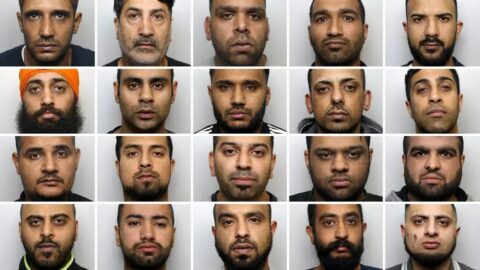It’s possible that the current upswell of anger about the decade-long cover-up of organized child rape gangs in English towns and cities may come to nothing … or it could result in a complete breakdown of law and order:

Like professional basketball, those accused of being members of “grooming gangs” tend to be monocultural.
The grooming gang thing has really blown up in the past couple of weeks. I’m not sure wholly why myself but a couple of guesses.
One is that the media really couldn’t report all that much — and for the same reason that Tommy Robinson got jailed one time around. Because there have been multiple ongoing cases and full reporting of one could — and probably would too — prejudice a jury in subsequent cases. So, those ongoing cases mean that the subject is more or less sub judice and can’t, in volume or detail, be talked about.
Thus things like Guardian reporting. Where you get the news that a gang has been tried, found guilty, sent off to jail. And no comment on who they were. Well, except for a list of names all of which are, shall we say, less than Anglo Saxon or even Viking in origin. We all draw our own conclusions at that point.
[…]
The number of abused — which means children raped, recall, arses blown up with pumps so that adult dicks can multiply penetrate to be detailed — starts to be counted up into the thousands. The tens of thousands perhaps.
There’s a point there at which I don’t think that normal societal agreement to allow the authorities to handle things works any more. At some point along that spectrum then significant civil violence breaks out.
Which brings me to the two questions. What is that number which, when known, leads to actual riots? And no, I don’t mean 15 meatheads lobbing half bricks at the police. Actual real and sustained loss of civilian authority control. The second, obviously, is are we going to reach that number?
In short, what is the level of betrayal of these girls that leaves the mob triumphant over law and order?
What really worries me is that I have a horrible — even if still slight at this point — suspicion that there was enough vileness done to enough young girls that we’re going to find out.
On Substack, Francis Turner shares concerns about the mass rapes of children and young women over too many years:
The scandal has been going on for at least 25 years and probably a decade more. That means that every year around 1000 new girls have been gang raped by the gangs.
Every year around 1000 new girls have been gang raped by the gangs
There are roughly 300,000 girls of each year cohort in the UK so that means one in around 300 girls of any age group has been gang-raped. Given that there are large chunks of the UK which are not places where the ~50 identified rape gangs have operated and indeed are places without residents of the relevant ethnicity (primarily Pakistani and Somali in a couple of cases) that means that the number goes way up in those areas. It seems likely that in one those 50 areas the ratio of new victims to their year group is more like 1 in 100 or 1%, especially when you remove the Pakistani girls that probably weren’t targeted even if some of them were in fact abused at home.
In places like Telford if you see a school year group photo for any year in a Comprehensive school in the last 30+ years at least one of the girls in that photo was being gang-raped
If successful steps had been taken in ~2010 to stop the abuse then about 15,000 girls would not have been gang-raped.
The Tory party and civil service disgust of Tommy Robinson has had the result that about 5000 girls were gang raped between when Tommy Robinson started going about the issue in around 2018 and 2023 when Sunak finally set up the national Grooming Gangs Taskforce.
If Substack would let me do a table this would be easier. However here is a summary of girls gang-raped under the prime ministers of this century based on a simple linear model
Starmer: 500 (to date)
Sunak: 1700
Truss: <100
Johnson: 3000+
May: 3000
Cameron: 6000+
Brown: 3000-
Blair: 10,000Probably half of Blair’s 10,000 was before anyone was aware that this was a systemic problem, but it was known to be a potential problem by at least 2004 when
[a] Channel 4 documentary about claims young white girls in Bradford were being groomed for sex by Asian abusers is delayed as police forces warn it could inflame racial tensions. It was finally shown three months later.
If the UK had got serious about stopping grooming gangs back in 2004 then over half of the gang rape victims could have been saved from such a terrible experience.
Take that 35,000 number a different way. There are roughly 35 million women in the UK. So one in a 1000 women in the UK have been gang-raped over the decades.




